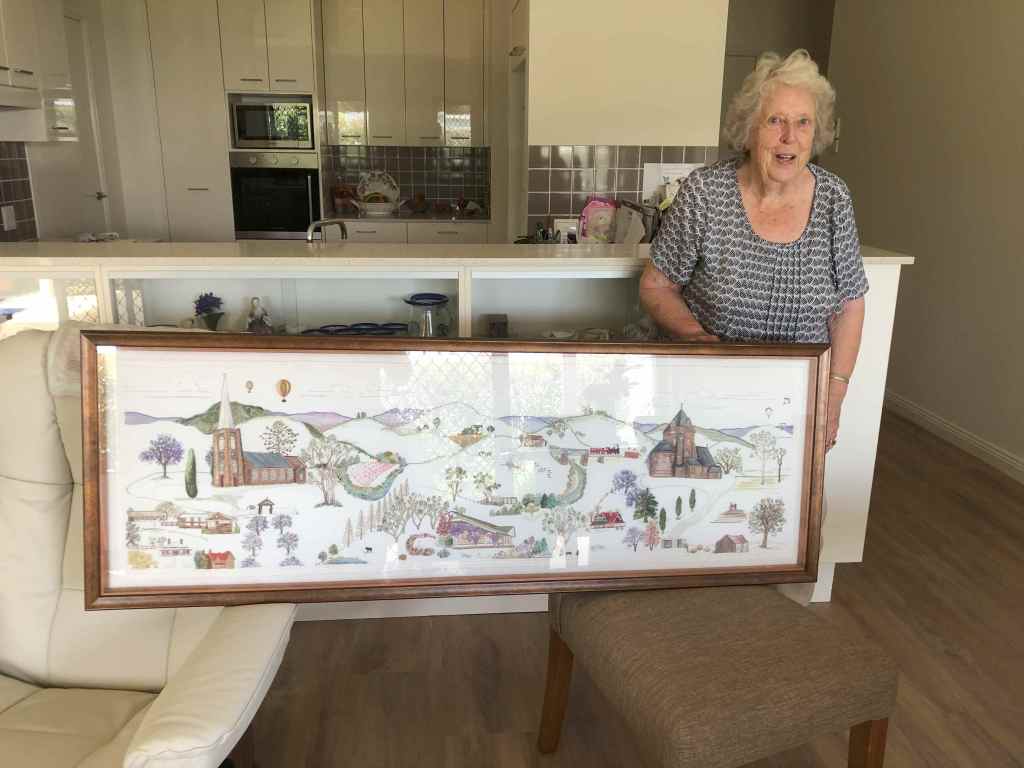2011 Camden Show Embroidery by Elaine Balla
Embroidery artist Elaine Balla created a decorative artwork about the Camden Show in 2011 for its 125th anniversary called ‘The Camden Show. ‘
Elaine entered her embroidery work in the competitive arts and crafts section of the show and won the Champion Exhibit Ribbon.
The art of embroidery has long been popular with local women and has a history that goes back to ancient times.
What is embroidery?
Embroidery is a decorative art or craft in which the artist uses fabric and other materials to apply thread or yarn using a variety of styles and stitches.
The art of embroidery is practised worldwide and can be traced to ancient China. In medieval England, high art was controlled by guilds and used in textiles in church rituals.
Embroidery was used to tell stories and as a form of biography at a time when women had few legal rights and were mostly illiterate. It was an expression of women’s agency.
Embroidery was passed down through generations of women who were the gatekeepers of community storytelling and secrets.
Embroidery artwork ‘The Camden Show’
Elaine spoke to Camden Historical Society president Ian Willis about her artwork, ‘The Camden Show’ and her other embroidery work.
Elaine said, ‘The Camden Show work took a couple of months to complete. ‘
She said, ‘I was under pressure to do the work due to the date of the 2011 Camden Show as the deadline’.

The Camden Show work is an example of crewel embroidery using thicker thread than silk-cotton embroidery threads, with some highlights in silk and gold, e.g., the balloons.
Elaine first drew the artwork on paper and then transferred the design to the linen cloth on which the embroidery was worked.
The artwork tells the story of the Camden Show. The centrepiece is a representation of the show ring with fireworks going off behind the show rotunda.
Cattle are found in the top right-hand corner of the work, proceeding around the ring. The story then moves through the poultry pavilion to the show hall displays, including flowers, jams, cakes, and photographs.
At the bottom of the work are the entry gates. The design then moves onto the ferris wheel and other sideshow stalls, including the Dodgem cars and clowns with moving heads.
The rural exhibitors, including the tractors, other farm equipment, and the show jumping, are in the top left corner of the embroidery work.
Beneath the title are fruit and vegetable displays along with the flowers.
The embroidery is a wonderful representation of a very popular community event.
Embroidery artwork, ‘Family Story’
Another work Elaine entered at the Camden Show in 2010 was ‘Family Story’.
The work tells the story of her family, the farm, the villages of Menangle, and the town of Camden, centred on St John’s Anglican Church and St James Anglican Church.
The centre of the work shows the family farm, the house with the family’s dogs, Tiger, Suzie and Rusty.
Elaine said, ‘The work is a panorama of her life story in Menangle.’
She finished the work over several months.
‘I completed a couple of hours every night’, she said.
In 2010, Elaine was featured in an article in the Camden press after winning the Most Outstanding Exhibit at the 2010 Camden Show with the embroidery.
The work is 140 centimetres by 55 centimetres and ‘featured over 40 years of memories’. (Camden Advertiser, 2010, ud)
‘I just wanted to have memories of where we have been. Places change. It’s really just a memory of our times,’ she said. (Macarthur Chronicle 2010)
She was ‘delighted, pleased and happy to win the prize.’ (Macarthur Chronicle, 2010)
‘I don’t really go in shows to win’. (Macarthur Chronicle, 2010)
She said, ‘If people do not enter their craftwork into the show, there won’t be a show’. (Camden Advertiser, 2010, ud)
Elaine said that she started embroidery when she was 12 years old and asked her mother if she could do an embroidery. The first work she attempted was an apple, and then she moved on to bigger projects.
Husband Steve proudly admits that Elaine put ‘a lot of effort into her work’.
Elaine and her husband Steve recently moved into Menangle’s Durham Green, downsizing from the family farm. The framed embroidery has brought many happy memories from the farm with her.
Exhibition at the Campbelltown Arts Centre
Elaine Balla is a member of the Embroiderer’s Guild of NSW, Campbelltown Group, and she was featured in a retrospective was part of the “Ruby” Exhibition of The Embroiderers Guild NSW, Campbelltown Group, at the Campbelltown Arts Centre held between 10-12 February 2023.
The image gallery below is a selection of Elaine Balla’s embroidery work at the ‘Ruby’ Exhibition at the Campbelltown Arts Centre in 2023, with images provided by Joan Kolar.







Elaine exhibited around 50 works in a variety of embroidery styles, representing 60 years of embroidery artwork.
The embroidery artworks included varying styles and pieces, including tablecloths, pictures, cushion covers and more.
The embroidery was done on linen, silk, and Madeira linen in styles including crewel, drawn-thread, pulled-thread, cross-stitch, Goldsworthy, cut-work, and more.
Elaine has exhibited her embroidery elsewhere in Australia and overseas.
The Campbelltown Group of the Embroiler’s Guild in NSW features a triennial exhibition at the Campbelltown Arts Centre.
Reference
Elaine Balla, Interview, 4 February 2024.
Joan Kolar, Group Convenor, Embroiderers’ Guild NSW Inc., Campbelltown Group, Email, 5 February 2023.
Joan Kolar, Images from ‘Ruby’ Exhibition at Campbelltown Arts Centre, 2023.
Updated 13 February 2024. Originally posted on 11 February 2024.











You must be logged in to post a comment.